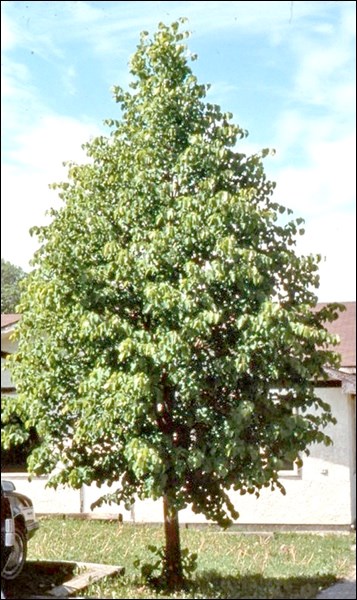As our community and residential trees are increasingly under attack by various diseases and insects, it is imperative that we plant different species and resistant varieties. Never has the need for diversification been so critical. In the first part of this article, some of these trees were described. Here are more, some old and some new, that will help to diversify our urban landscapes.
American larch or tamarack (Larix laricina) (50 by 20 ft.) is native to the boreal forests of the Prairies but adapts well to urban landscapes. It’s an “evergreen” that’s not – its bright green needles turn a brilliant yellow in autumn and then fall, leaving it naked through the winter. The small cones appear as tiny wooden rosettes. Siberian larch (Larix sibirica) is another option.
Spring Snow Siberian flowering crabapple (Malus baccata) (20 by 15 ft.) has been around for decades. It was developed by Bert Porter of Honeywood Lilies in Parkside in the 1960s. Porter was interested in fruit and this tree is female sterile, producing double white flowers but no apples. It’s perfect for fastidious gardeners who don’t want a mess of fallen apples. Passed on to a nursery in Iowa, in the intervening half century it has become the leading flowering crabapple cultivar in North America, with more than three million trees produced and sold since its release.
Gladiator flowering crabapple (Malus by Durleo) (20 by 13 ft.), a recent selection by Rick Durand, has a narrow oval shape with single medium pink flowers in spring, purplish summer foliage, deep purple fall foliage and small purple-red crabapples. More upright than most crabapples, it has high disease resistance and is well suited to any landscape with limited space.
Swiss stone pine (Pinus cembra) (40 by 20 ft.) is often overlooked simply because it is slow growing. But it is long lived – truly a tree you plant for coming generations. The long, soft dark green needles are in bundles of five, resistant to sunscald and retained for up to five years.
Ming Amur cherry (Prunus maackii Ming) (25 by 15 ft.) is a cross between a sour and Amur cherry developed at the University of Saskatchewan. It has attractive golden bark with prominent lenticels that is resistant to frost cracking, white flowers in spring and sparse, small fruit. Its form is upright and rounded and the dark green foliage turns yellow in fall. An excellent specimen or accent tree for residences.
Shooting Star northern pin oak (Quercus ellipsoidalis DurMarg) (35 by 30 ft.) was selected by Rick Durand and is grafted onto bur oak root stock to enable it to perform well on our drier, high pH soils. It has a rounded open form and dark red fall colour.
Top Gun bur oak (Quercus macrocarpa ByDur) (50 by 15 ft.) has a strong central leader and a narrow, upright form, ideally suited to smaller spaces. Little pruning is needed. It was selected by Rick Durand from a native oak stand in Manitoba.
Showy mountain ash (Sorbus decora) (25 by 20 ft.) has a rounded crown and open canopy. Hardy and slow growing, it is resistant to fireblight. It has almost tropical looking compound foliage, large, flat-topped creamy flowers and clusters of red fruit that are retained through winter until consumed by flocks of marauding waxwings. (Entertainment at no extra cost.)
Lone Star little leaf linden (Tillia cordata BySkinner) (40 by 25 ft.) has a pyramidal shape and shiny green foliage turning to yellow in the fall. The small yellow flowers are fragrant. The hardiest of the little leaf lindens, it is also resistant to stem cracking and sunscald. It was selected by Hugh Skinner of Manitoba.
Sara Williams is the author and coauthor of many books. She continues to give workshops on a wide range of gardening topics throughout the prairies.
— This column is provided courtesy of the Saskatchewan Perennial Society (SPS; saskperennial@hotmail.com ). Check our website (www.saskperennial.ca) or Facebook page (www.facebook.com/saskperennial) for a list of upcoming gardening events.
Lone Star little leaf linden is hardy and resistant to disease and insects. Photo by Sara Williams
Spring Snow flowering crabapple is ideal for those who want flowers but no messy apples on their lawn. Photo courtesy Aubin’s Nursery



